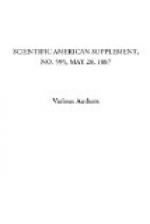Sir David Brewster long ago pointed out the remarkable physical characters presented by the curious product of the vegetable world known as “tabasheer,” though so far as I can find out it has not in recent years received that attention from physicists which the experiments and observations of the great Scotch philosopher show it to be worthy of.
Tabasheer seems to stand in the same relation to the mineral kingdom as do ambers and pearls. It is in fact an opal formed under somewhat remarkable and anomalous conditions which we are able to study; and in this aspect I have for some time past been devoting a considerable amount of attention to the minute structure of the substance by making thin sections and examining them under the microscope. It may be as well, perhaps, to give a short sketch of the information upon the subject which I have up to the present time been able to obtain, and in this way to call attention to points upon which further research seems to be necessary.
From time immemorial tabasheer has enjoyed a very high reputation in Eastern countries as a drug. Its supposed medicinal virtues, like those of the fossil teeth of China and the belemnites ("thunderbolts”) of this country, seem to have been suggested by the peculiarity of its mode of occurrence. A knowledge of the substance was introduced into Western Europe by the Arabian physicians, and the name by which the substance is generally known is said to be of Arabic origin. Much of the material which under the name of “tabasheer” finds its way to Syria and Turkey is said, however, to be fictitious or adulterated.
In 1788 Dr. Patrick Russell, F.R.S., then resident at Vizagapatam, wrote a letter to Sir Joseph Banks in which he gave an account of all the facts which he had been able to collect with respect to this curious substance and its mode of occurrence, and his interesting letter was published in the Philosophical Transactions for 1790 (vol. lxxx., p. 273).
Tabasheer is said to be sometimes found among the ashes of bamboos that have been set on fire (by mutual friction?). Ordinarily, however, it is sought for by splitting open those bamboo stems which give a rattling sound when shaken. Such rattling sounds do not, however, afford infallible criteria as to the presence or absence of tabasheer in a bamboo, for where the quantity is small it is often found to be closely adherent to the bottom and sides of the cavity. Tabasheer is by no means found in all stems or in all joints of the same stem of the bamboos. Whether certain species produce it in greater abundance than others, and what is the influence of soil, situation, and season upon the production of the substance, are questions which do not seem as yet to have been accurately investigated.
Dr. Russell found that the bamboos which produce tabasheer often contain a fluid, usually clear, transparent, and colorless or of greenish tint, but sometimes thicker and of a white color, and at other times darker and of the consistency of honey. Occasionally the thicker varieties were found passing into a solid state, and forming tabasheer.




